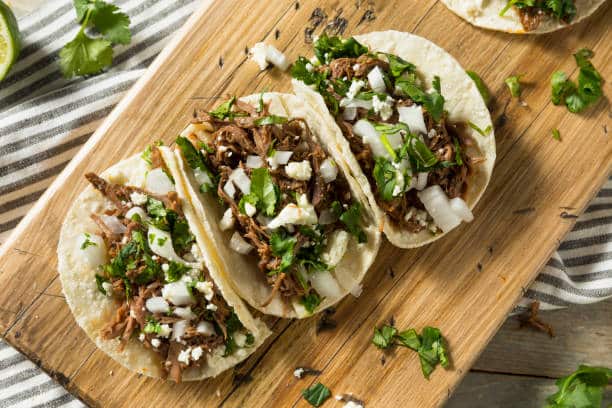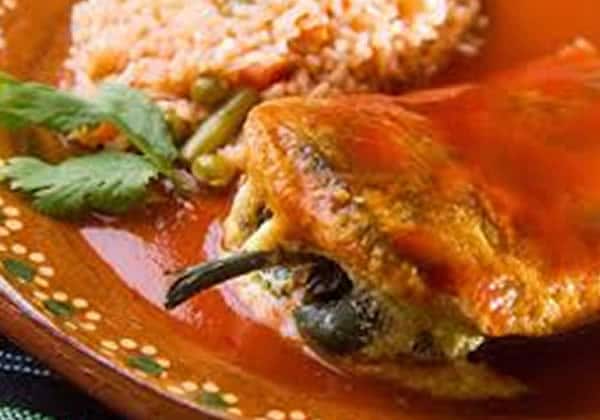
Tacos
Tacos, the personification of Mexican street food culture, are a testimony to the rich culinary history of Mexico. Let’s explore the fascinating world of Mexican tacos, their origins, countless variations, the art of preparation, the essential ingredients, and the cookware used to create these culinary delights
Tacos Unveiling Mexico’s Culinary Treasure
Origins
Tacos roots stretch back to ancient indigenous cultures in Mesoamerica, who relied on tortillas made from maize (corn) as a dietary staple. The term “taco” itself has Aztec origins, likely derived from the Nahuatl word “tlahco,” signifying a folded or rolled tortilla.
Variations
Mexican tacos differ in texture and ingredients depending on the regional ingredients and customs. They come in countless variations across the country. Each style showcases the unique flavors and culinary traditions of its region. Here are some prominent types
Tacos al Pastor (Shephard Style)
Origin Inspired by Middle Eastern shawarma brought by Lebanese immigrants, tacos al pastor emerged in Mexico City.
Ingredients Thinly sliced marinated pork, typically seasoned with achiote, adobo spices, and pineapple. Garnish them with diced onions, fresh cilantro, and a squeeze of lime.
Preparation Stack marinated pork onto a vertical rotisserie to create a tower. Afterward, slice it off and serve it in tortillas.
Tacos de Asada (Roast)
Origin Originating from northern Mexico, especially Sonora, people know these tacos for their grilled beef.
Ingredients Thinly sliced marinated beef (often flank or skirt steak), diced onions, fresh cilantro, and lime wedges.
Preparation Marinate the beef, then grill it to perfection, giving it an irresistible smoky and charred flavor.
Tacos de Carnitas (Little Meats)
Origin Carnitas, which translates to “little meats,” originate from Michoacán, showcasing the art of slow-cooked, tender pork.
Ingredients Slow-cooked, shredded pork, diced onions, fresh cilantro, salsa, and lime.
Preparation Braise the pork until it’s succulent and tender, then fry it until it becomes crispy, creating a delightful contrast in textures.
Tacos de Barbacoa (Barbacue)
Origin Hailing from the southern state of Hidalgo, barbacoa is all about slow-cooked meat, often beef or lamb.
Ingredients Tender, slow-cooked meat, often flavored with aromatic spices, diced onions, fresh cilantro, and a rich consommé broth.
Preparation Slow-cook the meat to perfection, and then serve it with the flavorful broth.
Ingredients
Tortillas Although corn tortillas are the traditional choice, many people also use flour tortillas. Warm them on a griddle or skillet before serving.
Proteins Fill tacos with a variety of proteins, such as beef, pork, chicken, fish, shrimp, and even vegetarian options like grilled mushrooms or cactus.
Toppings Personalization is key, and you can customize your tacos with toppings such as diced onions, fresh cilantro, shredded lettuce, sliced radishes, avocado slices, and various salsas.
Salsas Salsas are a pivotal component, enhancing the flavors of tacos. Common options include salsa verde (green sauce), salsa roja (red sauce), pico de gallo (fresh tomato, onion, and cilantro salsa), and fiery habanero salsa.
Lime Wedges A squeeze of fresh lime wedges is almost mandatory, infusing a zesty brightness to the tacos.
Cookware
Griddle or Skillet
A flat griddle or skillet is indispensable for warming tortillas and cooking proteins or vegetables.
Tongs
These come in handy for flipping and handling hot ingredients safely.
Cutting Board and Knife
For slicing and dicing toppings and proteins with precision.
Serving Platter
A generously sized platter or plate provides ample space for assembling and serving your delectable tacos.
Preparation
Prepare Fillings
Begin by seasoning and cooking your chosen protein to perfection. To achieve tender and flavorful results, use grilling, pan-frying, or slow-cooking methods.
Warm Tortillas
Heat the tortillas on a griddle or in a dry skillet until they become soft, pliable, and slightly charred, infusing a subtle smokiness.
Assemble
Arrange warm tortillas, add the cooked protein, and layer on the fresh toppings of your choice, such as diced onions, cilantro, salsa, and a squeeze of lime.
Enjoy
Fold the tortilla, roll it up, or leave it open-faced, then take a satisfying bite into the harmonious blend of flavors and textures.
Nutritional value
Tacos come in various styles, including beef, chicken, fish, vegetarian, and more. Because of this, the nutritional value of tacos can vary widely depending on the type of tacos and their ingredients.
Here’s a general idea of the nutritional content for a typical beef taco with standard ingredients (one taco shell with ground beef, lettuce, tomato, cheese, and sour cream).
- Calories – Approximately 200-300 calories per taco.
- Protein – Around 10-15 grams of protein, primarily from the beef and cheese.
- Carbohydrates – Roughly 15-20 grams of carbohydrates, mainly from the taco shell and vegetables.
- Fat – Approximately 10-15 grams of fat, largely from the beef, cheese, and sour cream.
- Fiber – Tacos can provide some dietary fiber, usually 2-4 grams per taco, mainly from the lettuce and tomato.
- Sodium – The sodium content can vary depending on the seasoning used in the beef and the amount of cheese and sour cream added. It’s typically in the range of 300-500 milligrams per taco.
- Vitamins and Minerals – Tacos may contain essential vitamins and minerals, such as vitamin C from the tomato and vitamin A from the lettuce.
You can customize tacos with a wide range of ingredients, such as different types of meat or protein, a variety of vegetables, salsas, and toppings. These choices can have a significant impact on their nutritional content.
If you’re looking for more precise nutritional information, it’s advisable to refer to the specific ingredients and preparation method used for the tacos you are consuming.
Conclusion
Tacos are continuously evolving; they represent Mexico’s culinary heritage, diverse flavors and culinary technique.
Whether you’re enjoying them at a bustling street vendor’s stall in Mexico City or making your own gourmet versions at home, each taco is a masterpiece of taste, tradition, and passion.
So, embrace the flavorful world of Mexican taco cuisine and celebrate in its rich tapestry of flavors!
Please see below for more Mexican popular dishes










